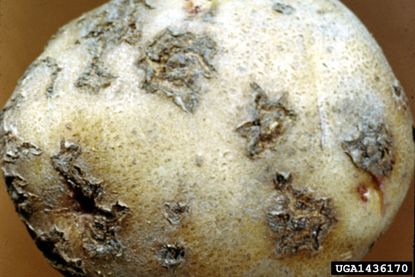What Is Potato Scab Disease: Tips On Treating Scab In Potatoes


Like elephant hide and silver scurf, potato scab is an undetectable disease that most gardeners discover at harvest time. Depending on the extent of the damage, these potatoes may still be edible once the scab is removed, but they're definitely not fit for the farmer's market. Read on to learn more about potato scab disease and how to prevent it next season.
What is Potato Scab?
Once you've unearthed scabby potatoes, you may ask yourself, “What causes potato scab?”. Unfortunately, the source of infection isn't a rare, short-lived pathogen; it's a soil bacteria that can remain in the ground indefinitely as long as decaying plant matter is left behind. The bacteria, Streptomyces scabies, thrives in soils with a pH above 5.5 and temperatures between 50 to 88 F. (10-31 C.). The growing conditions needed by potatoes are very close to the conditions that scab prefers. Potato tubers suffering from scab are covered in circular lesions that may appear dark and corky. When many lesions are present, they sometimes grow into one another, creating irregular patches of damage. Surface scabs are annoying but are usually able to be cut away and part of the potato salvaged. More serious diseases can develop, causing deep pitting and cracking that allows secondary pests and diseases to make their way into the tuber's flesh.
Treating Scab in Potatoes
Potato scab control is targeted at preventing infection in potatoes; once your potatoes are covered in scab, it's too late to treat. Future potato beds can be protected from scab by keeping the soil pH of beds around 5.2 with liberal applications of sulphur. Avoid the use of fresh manure where scab has been a problem; well-composted manure is generally free of pathogens due to the heat involved in the process. Always amend potato beds in the fall if scab is a perennial problem. Practicing crop rotation on four-year intervals can keep scab levels low, but never follow potatoes with the following crops since these plants are susceptible to scab:
Rye, alfalfa, and soybeans are believed to reduce scab problems when used in rotation with these root vegetables. Turn these cover crops just before planting for best results. Heavy irrigation during tuber formation has also been shown to be protective, but you'll have to keep the soil moist for up to six weeks. This technique requires great care; you want to keep the soil moist, but not waterlogged. Waterlogged soils encourage a whole new group of problems in potatoes. When potato scab disease is widespread in your garden despite your best efforts, you may want to try some of the scab-resistant potato varieties. Always choose certified seed to avoid bringing more scab to the party, but Chieftan, Netted Gem, Nooksack, Norgold, Norland, Russet Burbank, Russet Rural, and Superior seem particularly suited to scab-troubled gardens.
Gardening tips, videos, info and more delivered right to your inbox!
Sign up for the Gardening Know How newsletter today and receive a free download of our most popular eBook "How to Grow Delicious Tomatoes."

Kristi Waterworth was a regular contributor to Gardening Know How for many years, answering countless queries on plant pests and diseases.
-
 Urban Composting Guide: How To Compost In The Middle Of The City
Urban Composting Guide: How To Compost In The Middle Of The CityUrban composting does not have to be daunting. You can compost in the city, and maybe even try some urban worm composting!
By Mary Ellen Ellis
-
 Shrub Diseases And Pests To Watch Out For
Shrub Diseases And Pests To Watch Out ForShrub diseases and pests can be challenging. Learn how to recognize and eradicate them before they can present a danger to your plants.
By Susan Albert